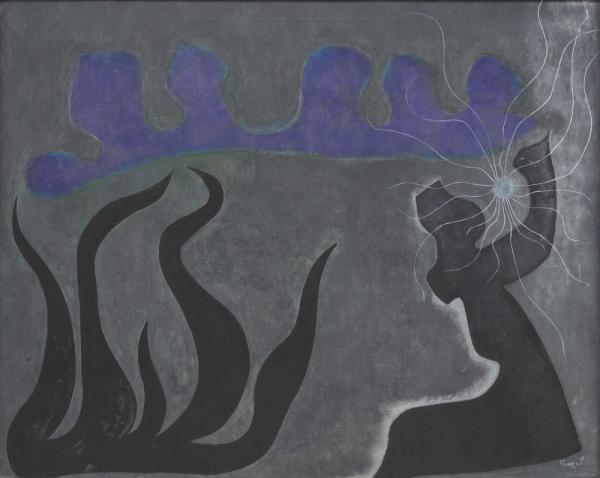Skip to main content
Sea Phantoms
Artist
William Baziotes
(Born 1912, United States; died 1963, United States)
Date1952
MediumOil on canvas
DimensionsUnframed: 40 1/4 × 60 in. (102.24 × 152.4 cm)
Framed: 50 × 62 × 2 in. (127 × 157.48 × 5.08 cm)
Framed: 50 × 62 × 2 in. (127 × 157.48 × 5.08 cm)
Credit LineCollection of the Modern Art Museum of Fort Worth, Gift of Anne and John Marion
Object number2000.9
Status
Not on viewCopyright© Estate of William Baziotes
Category
Label TextSea Phantoms, 1952, is representative of William Baziotes’s mature style, which is dominated by enigmatic, Surrealist-inspired abstract landscapes. Typical of the artist’s compositions, the shapes in this painting float unmoored across the picture plane, defying traditional compositions in which the main attraction is at the center of the canvas.
The color scheme of Sea Phantoms evokes an aquatic view, with abstracted forms that are distinctly biomorphic. The purple “comb” at the top of the canvas suggests a sea organism or a line of rolling ocean waves. Other shapes verge on figuration; the curving black silhouette partially outlined in gray at the lower right recalls a female figure who is reaching up through the shadowy space. The light blue sphere that radiates white lines at the upper right is a recurring motif in Baziotes’s painting and reflects the artist’s personal symbolic language of forms. Sea Phantoms is mythological and dreamlike, as well as Darwinian in its traces of growth and evolving life. Its meaning, however, remains elusive.
Baziotes developed friendships with several of the European Surrealists who migrated to the United States after World War II. The most overt link to Surrealism in his work is through the Spanish artist Joan Miró (1893–1983). Miró’s hallucinatory landscapes epitomize the Surrealists’ focus on the unconscious, and his scattered compositions of repeated abstract motifs (including radiating forms, like the one in Sea Phantoms) can be seen in Baziotes’s work, reinvented with his personal style.
The color scheme of Sea Phantoms evokes an aquatic view, with abstracted forms that are distinctly biomorphic. The purple “comb” at the top of the canvas suggests a sea organism or a line of rolling ocean waves. Other shapes verge on figuration; the curving black silhouette partially outlined in gray at the lower right recalls a female figure who is reaching up through the shadowy space. The light blue sphere that radiates white lines at the upper right is a recurring motif in Baziotes’s painting and reflects the artist’s personal symbolic language of forms. Sea Phantoms is mythological and dreamlike, as well as Darwinian in its traces of growth and evolving life. Its meaning, however, remains elusive.
Baziotes developed friendships with several of the European Surrealists who migrated to the United States after World War II. The most overt link to Surrealism in his work is through the Spanish artist Joan Miró (1893–1983). Miró’s hallucinatory landscapes epitomize the Surrealists’ focus on the unconscious, and his scattered compositions of repeated abstract motifs (including radiating forms, like the one in Sea Phantoms) can be seen in Baziotes’s work, reinvented with his personal style.








